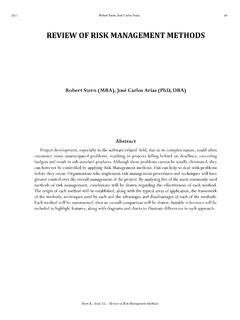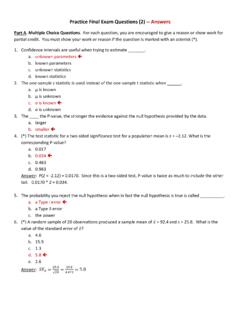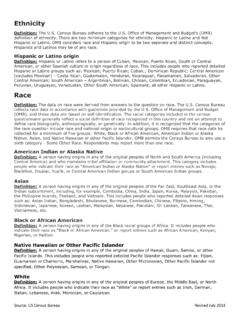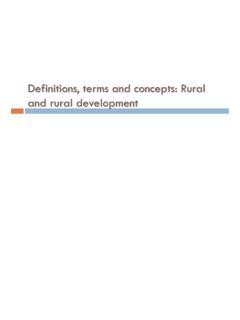Transcription of [Ch 6] Set Theory 1. Basic Concepts and Definitions
1 400 lecture note #4 [Ch 6] Set Theory 1. Basic Concepts and Definitions 1) Basics Element: | ; A is a set consisting of elements x which is in a/another set S such that P(x) is true. Empty set: notated { } (or Subset: ; A is a subset of B. This also implies , . o Example: 3,4,5 , ! "| ! # 2 ,% 3,4,5 Then we have relations (a partial list): , % , %, % Proper subset: ; (1) A is a subset of B, and (2) there is at least one element in B that is not in A. o Example: 3,4,5 , ! "| ! # 2 ,% 3,4,5 Then followings are true (a partial list): , % , %, % Set equality: A = B ; this happens if and only if ()* . o Example: [Example Set Equality, p. 339] Define sets A and B as follows: A = {m Z | m = 2a for some integer a} B = {n Z | n = 2b 2 for some integer b} Is A = B? Solution: Yes. To prove this, both subset relations A B and B A must be proved.
2 A. Part 1, Proof That A B: Suppose x is a particular but arbitrarily chosen element of A. [We must show that x B. By definition of B, this means we must show that x = 2 (some integer) 2.] By definition of A, there is an integer a such that x = 2a. [Given that x = 2a, can x also be expressed as 2 (some integer) 2? , is there an integer, say b, such that 2a = 2b 2? Solve for b to obtain b = (2a + 2)/2 = a + 1. Check to see if this works.] Let b = a + 1. [First check that b is an integer.] Then b is an integer because it is a sum of integers. [Then check that x= 2b 2.] Also 2b 2 = 2(a + 1) 2 = 2a + 2 2 = 2a = x, Thus, by definition of B, x is an element of B [which is what was to be shown]. b. Part 2, Proof That B A: Will work on this part in the class. 2) Intervals To represent an interval on a one-dimensional space, square brackets ([ ]) and parentheses ( ) are used, where [ ] denotes inclusion and () denotes exclusion.
3 2. Operations on sets Venn Diagrams . / Example [Example ] Let the universal set be the set U = {a, b, c, d, e, f, g} and let A = {a, c, e, g} and B = {d, e, f, g}. Find A B, A B, B A, and Ac. Solution: A B = {a, c, d, e, f, g}, A B = {e, g}, B A = {d, f}, Ac = {b, d, f} Notice NO DUPLICATES in union and intersection sets. Exercise 1: [Section , Exercise #10, p. 350] Let the universal set be the set R of all real numbers and let A = {x R| 0 < x 2}, B = {x R| 1 x < 4}, and C = {x R| 3 x < 9}. Find each of the following: a. A B b. A B c. Ac d. A C e. A C f. Bc Exercise 2: [Section , Exercise #3, p. 350, modified] Let sets R and S be defined as follows: R = {x Z | x is divisible by 2} S = {y Z | y is divisible by 3} a. Characterize the set R S b. Characterize the set R S c. Characterize the set (R S)c More Concepts Disjoint sets: Mutually disjoint sets: definition : Sets A1, A2.
4 An are mutually disjoint ( , non-overlapping) if and only if for any two sets Ai and A1, 0 1 (empty set). o Example: B1 = {2, 4, 6}, B2 = {3, 7}, and B3 = {0, 5}. B1, B2, B3 are mutually disjoint. Partition of a set: definition : Sets A1, A2,.. An are a partition of a set B if and only if: B is a union of all the Ai , that is, 03045, and A1, A2,.. An are mutually disjoint. o Examples: 1. Let A = {1, 2, 3, 4, 5, 6}, A1 = {1, 6}, A2 = {3}, and A3 = {2, 4, 5}. The set of sets {A1, A2, A3} is a partition of A. 2. Let Z be the set of all integers and let T0 = {n Z| n = 3k, for some integer k}, T1 = {n Z| n = 3k + 1, for some integer k}, and T2 = {n Z| n = 3k + 2, for some integer k}. The set of sets {T0, T1, T2} is a partition of Z. Exercise [Section , #28, p. 351] Let E be the set of all even integers and O the set of all odd integers. Is {E, O} a partition of Z, the set of all integers?
5 Explain your answer. Power set of A (denoted (A)) is the set of al subsets of A. o Example: Find the power set of the set {1, 2, 3}. Answer: {{}, {1}, {2}, {3}, {1,2}, {2,3}, {1,3}, {1,2,3}} Cartesian Products of n sets A1,..An, denoted 78 98 ..8 ), is the set of all ordered n-tuples (7,(9,..,() where (7 7, (9 9 and so on. In particular, 78 9 (7,(9 |(7 7 ()* (9 9 . Exercise [Section , #31, p. 351] Suppose A = {1, 2} and B = {2, 3}. Find each of the following: (A B) (A) (A B) (A B) 3. Set Properties Some Basic properties of sets which involve union, intersection, complement and difference. Example: [Example , p. 353] prove Theorem (1)(a): For all sets A and B, A B A. Proof: [Skeleton only] To Show: A B A. To prove that A B A, you must show that x, if x A B then x A. from the Procedural version of Set Definitions above. Steps: o You suppose x is an element in A B, and then o You show that x is in A.)))))))
6 To say that x is in A B means that x is in A and x is in B. This allows you to complete the proof by deducing that, in particular, x is in A, as was to be shown. Note that this deduction is just a special case of the valid argument form p q p. Set Identities Identity relations on sets Proving Set Identities (procedurally; by element membership) To prove two sets are equal, we must show both directions of the subset relation: Also again, use the procedural version of the set Definitions and show the membership of the elements. o Example 1: [Example Proof of DeMorgan s Law for Sets, p. 359] prove (true) that for all sets A and B, (A B)c = A c B c. Proof: [Skeleton only] We must show that (A B) c A c B c and that A c B c (A B) c. To show the first containment means to show that x, if x (A B) c then x A c B c. And to show the second containment means to show that x, if x A c B c then x (A B) c.
7 Since each of these statements is universal and conditional, for the first containment, you suppose x (A B)c, and then you show that x Ac Bc. And for the second containment, you suppose x Ac Bc, and then you show that x (A B) c. To fill in the steps of these arguments, you use the procedural versions of the Definitions of complement, union, and intersection, and at crucial points you use De Morgan s laws of logic. [The entire proof is presented on p. 360-361]. o Example 2: [Example Finding a Counterexample, p. 367] Is the following set property true? -- For all sets A, B, and C, (A B) (B C) = A C. Proof: By counterexample. Let A = {1, 2, 3, 4, 5}, B = {2, 3, 5, 6} and C = {4, 5, 6, 7}. Then A B = {1, 4}, B C = {2, 3}, A C = {1, 2, 3} Hence (A B) (B C) = {1, 4} {2, 3} = {1, 2, 3, 4}, whereas A C = {1, 2, 3}. Since {1, 2, 3, 4, 5} = {1, 2, 3}, we have that (A B) (B C) = A C.
8 Exercises: 1. [Section , Exercise #3, p. 365] The following is a proof that for all sets A, B, and C, if A B and B C, then A C. Fill in the blanks.. Will work on this in the class, but you can find an answer at the back of the textbook. Proof: Suppose A, B, and C are sets and A B and B C. To show that A C, we must show that every element in (a) is in (b) . But given any element in A, that element is in (c) (because A B), and so that element is also in (d) (because (e) ). Hence A C. 2. [Section , Exercise #5, p. 365] prove that for all sets A and B, (B A) = B Ac. Proof: .. Will work on this in the class, but you can find an answer at the back of the textbook. 3. [Section , Exercise #6, P. 372] prove the statement if that is true, or find a counterexample if false. Assume all sets are subsets of a universal set U. For all sets A, B, and C, A (A B) = A. Proof.
9 Will work on this in the class, but you can find an answer at the back of the textbook. Proving Set Identities Algebraically Alternatively, we can prove set properties algebraically using the set identity laws. o Example: [Example Deriving a Set Difference Property, p. 371] Construct an algebraic proof that for all sets A, B, and C, (A B) C = (A C) (B C). Cite a property from Theorem for every step of the proof. Solution: Let A, B, and C be any sets. Then (A B) C = (A B) Cc by the set difference law = Cc (A B) by the commutative law for = (Cc A) (Cc B) by the distributive law = (A Cc) (B Cc) by the commutative law for = (A C) (B C) by the set difference law. o Exercise: [Section , #31, p. 373] For all sets A and B, A B A A B. Proof: .. Will work on this in the class, but you can find an answer at the back of the textbook. 4. Boolean Algebra 1) Correspondence between logical equivalency rules and Set properties: Logical operator --- Set Logical operator --- Set Logical operator ~ --- Set c (complement) Logical value t (a tautology) Set U (a universal set) Logical value c (a contradiction) Set (an empty set) In fact, both are special cases of the same general structure, known as a Boolean algebra.
10 2) definition of Boolean Algebra [Wikipedia, #Boolean_algebras:_the_definition ] In mathematics and mathematical logic, Boolean algebra is the branch of algebra in which the values of the variables are the truth values true and false, usually denoted 1 and 0 respectively. Instead of elementary algebra where the values of the variables are numbers, and the main operations are addition and multiplication, the main operations of Boolean algebra are the conjunction and denoted as , the disjunction or denoted as , and the negation not denoted as . It is thus a formalism for describing logical relations in the same way that ordinary algebra describes numeric relations. [Textbook p. 375] In any Boolean algebra, o the complement of each element is unique; and o the quantities 0 and 1 are unique. Exercise [Section , Exercise #1, p. 381] Assume that B is a Boolean algebra with operations + and . Give the reasons needed to fill in the blanks in the proofs, but do not use any parts of Theorem unless they have already been proved.







![[Ch 3, 4] Logic and Proofs (2) 1. Valid and Invalid ...](/cache/preview/d/5/4/f/1/b/4/3/thumb-d54f1b43140ae25ae5daa306e1f8330e.jpg)







